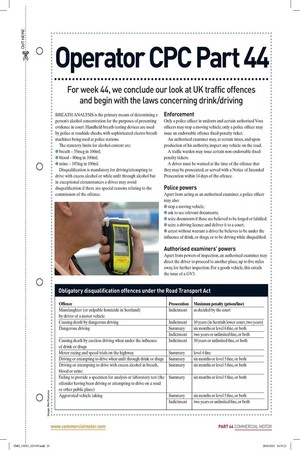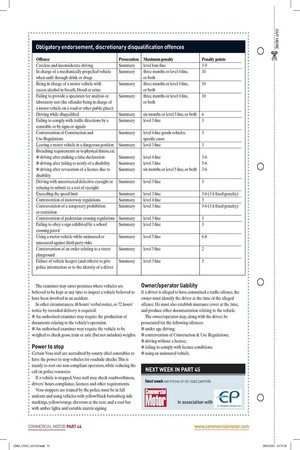Operator CPC Part 44
Page 23

Page 24

If you've noticed an error in this article please click here to report it so we can fix it.
For week 44, we conclude our look at UK traffic offences and begin with the laws concerning drink/driving
BREATH ANALYSIS is the primary means of determining a person's alcohol concentration for the purposes of presenting evidence in court. Handheld breath-testing devices are used by police at roadside checks, with sophisticated electro-breath machines being used at police stations. The statutory limits for alcohol content are: • breath — 35mcg in 100m1; • blood — 80mg in 100m1;
• urine — 107mg in 100m1.
Disqualification is mandatory for driving/attempting to drive with excess alcohol or while unfit through alcohol but in exceptional circumstances a driver may avoid disqualification if there are special reasons relating to the commission of the offence.
Enforcement
Only a police officer in uniform and certain authorised Vosa officers may stop a moving vehicle; only a police officer may issue an endorsable offence fixed-penalty ticket.
An authorised examiner may, at certain times, and upon production of his authority, inspect any vehicle on the road.
A traffic warden may issue certain non-endorsable fixedpenalty tickets.
A driver must be warned at the time of the offence that they may be prosecuted, or served with a Notice of Intended Prosecution within 14 days of the offence.
Police powers
Apart from acting as an authorised examiner, a police officer may also: • stop a moving vehicle; • ask to see relevant documents; • seize documents if these are believed to be forged or falsified; • seize a driving licence and deliver it to a court;
• arrest without warrant a driver he believes to be under the influence of drink, or drugs, or to be driving while disqualified.
Authorised examiners' powers
Apart from powers of inspection, an authorised examiner may direct the driver to proceed to another place, up to five miles away, for further inspection. For a goods vehicle, this entails the issue of a GV3.
The examiner may enter premises where vehicles are believed to be kept at any time to inspect a vehicle believed to have been involved in an accident.
In other circumstances, 48 hours' verbal notice, or 72 hours' notice by recorded delivery is required.
• An authorised examiner may require the production of documents relating to the vehicle's operation.
• An authorised examiner may require the vehicle to be weighed to check gross, train or axle (but not unladen) weights.
Power to stop
Certain Vosa staff are accredited by county chief constables to have the power to stop vehicles for roadside checks. This is mainly to root out non-compliant operators, while reducing the call on police resources.
If a vehicle is stopped, Vosa staff may check roadworthiness, drivers' hours compliance, licences and other requirements.
Vosa stoppers are trained by the police, must be in full uniform and using vehicles with yellow/black battenberg side markings, yellow/orange chevrons at the rear, and a roof bar with amber lights and variable matrix signing.
Owner/operator liability
If a driver is alleged to have committed a traffic offence, the owner must identify the driver at the time of the alleged offence. He must also establish insurance cover at the time, and produce other documentation relating to the vehicle. The owner/operator may, along with the driver, be prosecuted for the following offences: • under age driving; • contravention of Construction & Use Regulations; • driving without a licence; • failing to comply with licence conditions;
• using an uninsured vehicle.









































